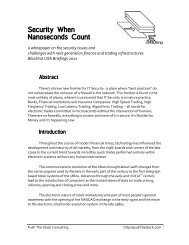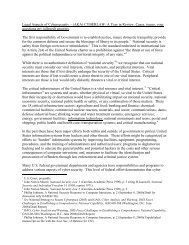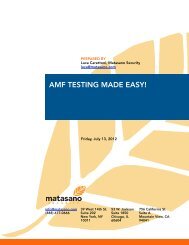Siemens Sima(c S7 PLC Exploita(on - Hakim
Siemens Sima(c S7 PLC Exploita(on - Hakim
Siemens Sima(c S7 PLC Exploita(on - Hakim
You also want an ePaper? Increase the reach of your titles
YUMPU automatically turns print PDFs into web optimized ePapers that Google loves.
<str<strong>on</strong>g>Siemens</str<strong>on</strong>g> <str<strong>on</strong>g>Sima</str<strong>on</strong>g>)c <str<strong>on</strong>g>S7</str<strong>on</strong>g> <str<strong>on</strong>g>PLC</str<strong>on</strong>g> <str<strong>on</strong>g>Exploita</str<strong>on</strong>g>)<strong>on</strong> <str<strong>on</strong>g>S7</str<strong>on</strong>g>-‐Fu () with Rapid7 Metasploit Black Hat USA+2011 Dill<strong>on</strong> Beresford d1n@nsslabs.com
Dill<strong>on</strong> Beresford Security Researcher at
With assistance from… NSS Labs, Project Funding Brian Meixell, Engineering Support. Ian Parker, Lab Setup and QA. Tim OMo, Hardware Procurement. Dale Peters<strong>on</strong> (DigitalB<strong>on</strong>d) Blog Bob Radvanovsky (SCADASEC) List INL/ICS-‐CERT, Disclosure Process <str<strong>on</strong>g>PLC</str<strong>on</strong>g>Trainer.NET (<str<strong>on</strong>g>PLC</str<strong>on</strong>g> Trainers)
IntroducV<strong>on</strong> • <str<strong>on</strong>g>PLC</str<strong>on</strong>g>s are computers used to automate mechanical device processes. • <str<strong>on</strong>g>PLC</str<strong>on</strong>g>s are used in the nuclear, oil and gas refineries, coal, water and waste treatment, transportaV<strong>on</strong>, aerospace, defense and commercial factories, am<strong>on</strong>g many other things… • The <str<strong>on</strong>g>S7</str<strong>on</strong>g>-‐300, and <str<strong>on</strong>g>S7</str<strong>on</strong>g>-‐400 are currently the most comm<strong>on</strong> <str<strong>on</strong>g>PLC</str<strong>on</strong>g>s in use, however the <str<strong>on</strong>g>S7</str<strong>on</strong>g>-‐1200 is gaining more tracV<strong>on</strong> . • <str<strong>on</strong>g>Sima</str<strong>on</strong>g>Vc <str<strong>on</strong>g>S7</str<strong>on</strong>g> <str<strong>on</strong>g>PLC</str<strong>on</strong>g>s offer state of the art PROFIBUS and PROFINET communicaV<strong>on</strong> protocols. • From an aMacker perspecVve, each of the <str<strong>on</strong>g>S7</str<strong>on</strong>g> <str<strong>on</strong>g>PLC</str<strong>on</strong>g>s have <strong>on</strong>e thing in comm<strong>on</strong>. They communicate over ISO-‐TSAP (RFC-‐1006) <strong>on</strong> TCP port 102. • When TSAP was layered <strong>on</strong> Top of TCP, security wasn’t factored in. • The <str<strong>on</strong>g>Sima</str<strong>on</strong>g>Vc <str<strong>on</strong>g>S7</str<strong>on</strong>g> <str<strong>on</strong>g>PLC</str<strong>on</strong>g>s run <strong>on</strong> a 32-‐bit Linux operaVng system. • <str<strong>on</strong>g>S7</str<strong>on</strong>g> <str<strong>on</strong>g>PLC</str<strong>on</strong>g> Firmware images are encrypted and hex encoded, some are using simple rotaVng shia sequences to obfuscate the strings in the firmware. • The <str<strong>on</strong>g>S7</str<strong>on</strong>g>-‐300 we are going to exploit has a TELNET daem<strong>on</strong> and HTTP server running as background process which are used by the <str<strong>on</strong>g>Siemens</str<strong>on</strong>g> developers for debugging. • The <str<strong>on</strong>g>S7</str<strong>on</strong>g>-‐1200 also has a web server included in it for diagnosVcs and HMI.
TesVng Devices Under Test: § <str<strong>on</strong>g>PLC</str<strong>on</strong>g>1 6E<str<strong>on</strong>g>S7</str<strong>on</strong>g> 212-‐1BD30-‐0XB0 AC/DC => <str<strong>on</strong>g>Siemens</str<strong>on</strong>g> <str<strong>on</strong>g>Sima</str<strong>on</strong>g>Vc <str<strong>on</strong>g>S7</str<strong>on</strong>g>-‐1200 § <str<strong>on</strong>g>PLC</str<strong>on</strong>g>2 6E<str<strong>on</strong>g>S7</str<strong>on</strong>g> 212-‐1BD30-‐0XB0 AC/DC => <str<strong>on</strong>g>Siemens</str<strong>on</strong>g> <str<strong>on</strong>g>Sima</str<strong>on</strong>g>Vc <str<strong>on</strong>g>S7</str<strong>on</strong>g>-‐1200 § <str<strong>on</strong>g>PLC</str<strong>on</strong>g>3 317-‐2EJ10-‐0AB0 => <str<strong>on</strong>g>Siemens</str<strong>on</strong>g> <str<strong>on</strong>g>Sima</str<strong>on</strong>g>Vc <str<strong>on</strong>g>S7</str<strong>on</strong>g>-‐300 § <str<strong>on</strong>g>PLC</str<strong>on</strong>g>4 317-‐2EJ10-‐0AB0 => <str<strong>on</strong>g>Siemens</str<strong>on</strong>g> <str<strong>on</strong>g>Sima</str<strong>on</strong>g>Vc <str<strong>on</strong>g>S7</str<strong>on</strong>g>-‐300 <str<strong>on</strong>g>PLC</str<strong>on</strong>g> Firmware Versi<strong>on</strong>s: § Versi<strong>on</strong> 2.2 => <str<strong>on</strong>g>Siemens</str<strong>on</strong>g> <str<strong>on</strong>g>Sima</str<strong>on</strong>g>Vc <str<strong>on</strong>g>S7</str<strong>on</strong>g>-‐1200 § Versi<strong>on</strong> 2.3.4 => <str<strong>on</strong>g>Siemens</str<strong>on</strong>g> <str<strong>on</strong>g>Sima</str<strong>on</strong>g>Vc <str<strong>on</strong>g>S7</str<strong>on</strong>g>-‐300
<str<strong>on</strong>g>Sima</str<strong>on</strong>g>Vc <str<strong>on</strong>g>S7</str<strong>on</strong>g>-‐1200
<str<strong>on</strong>g>Sima</str<strong>on</strong>g>Vc <str<strong>on</strong>g>S7</str<strong>on</strong>g>-‐300 “The Big Boys”
Step 7 Basic
What do those panels aMached to the <str<strong>on</strong>g>PLC</str<strong>on</strong>g>s do and how are they c<strong>on</strong>trolled?
<str<strong>on</strong>g>PLC</str<strong>on</strong>g> Trainer LAD Network
<str<strong>on</strong>g>PLC</str<strong>on</strong>g> Trainer LAD Network
<str<strong>on</strong>g>PLC</str<strong>on</strong>g> Trainer LAD Network
The <str<strong>on</strong>g>Siemens</str<strong>on</strong>g> <str<strong>on</strong>g>Sima</str<strong>on</strong>g>Vc <str<strong>on</strong>g>S7</str<strong>on</strong>g>-‐300, <str<strong>on</strong>g>S7</str<strong>on</strong>g>-‐400 and <str<strong>on</strong>g>S7</str<strong>on</strong>g>-‐1200 rely <strong>on</strong> the PROFINET IEEE 802.3 Ethernet standard, for industrial grade c<strong>on</strong>necVvity in envir<strong>on</strong>ments where Manufacturing ExecuV<strong>on</strong> Systems (MES) are criVcal.
PROFINET/ETHERNET Today there are over 3.5 milli<strong>on</strong> PROFINET enabled devices acVvely deployed. 4,500,000 4,000,000 3,500,000 3,000,000 2,500,000 2,000,000 1,500,000 1,000,000 500,000 PROFINET Nodes In Use By 2013 0 2006 2007 2008 2009 2010 2011 2012 2013
ISO-‐TSAP and <str<strong>on</strong>g>Sima</str<strong>on</strong>g>Vc <str<strong>on</strong>g>PLC</str<strong>on</strong>g>s • <str<strong>on</strong>g>S7</str<strong>on</strong>g> <str<strong>on</strong>g>PLC</str<strong>on</strong>g> listens <strong>on</strong> TCP Port 102 for c<strong>on</strong>necV<strong>on</strong>s. • Communicates w/Step 7 soaware over ISO-‐TSAP. • ISO-‐TSAP is layered <strong>on</strong> Top of TCP c<strong>on</strong>necV<strong>on</strong>s. • <str<strong>on</strong>g>S7</str<strong>on</strong>g> <str<strong>on</strong>g>PLC</str<strong>on</strong>g> also accepts remote commands over 102. • ISO-‐TSAP was designed with special-‐purpose interfaces in mind to be useful in the short term. • Expedites the process for development of TSAP based applicaV<strong>on</strong>s that need TCP.
ISO-‐TSAP Problems • Security was never factored into the equaV<strong>on</strong>. • Packets transmiMed o/ISO-‐TSAP are sent in plain-text.• The protocol was intended to be open and reliable. • Uses a ‘layering principle’ which means that even if an encrypted bridge between the client and server <strong>on</strong> top of the TCP is implemented it can sVll be MITM • The protocol hasn’t been revised or even looked at since the late 80s.
D<strong>on</strong>’t trust <str<strong>on</strong>g>Sima</str<strong>on</strong>g>Vc ‘ServerSessi<strong>on</strong>’ based c<strong>on</strong>necV<strong>on</strong>s. An aMacker, can disable or enable the CPU protecV<strong>on</strong> of a <str<strong>on</strong>g>PLC</str<strong>on</strong>g> by sending craaed packets over port 102. The aMacker can also c<strong>on</strong>trol the CPU’s internal operaV<strong>on</strong>al state, change logical operaV<strong>on</strong>s in the <str<strong>on</strong>g>PLC</str<strong>on</strong>g>’s OB1 porV<strong>on</strong> of memory and or shutdown processes c<strong>on</strong>nected to the <str<strong>on</strong>g>PLC</str<strong>on</strong>g>. The packets in the red are being generated and sent from the <str<strong>on</strong>g>Siemens</str<strong>on</strong>g> Step 7 Basic so7ware. The packets in the blue are being sent by the <str<strong>on</strong>g>PLC</str<strong>on</strong>g>. The en@re TCP stream is 11384 bytes. Pay close aEen@<strong>on</strong> to the ServerSessi<strong>on</strong>_ID in the red box, that liEle ID will play an important role later <strong>on</strong>.
<str<strong>on</strong>g>Siemens</str<strong>on</strong>g> claimed that they had a miVgaV<strong>on</strong> strategy in place, and they did, but it was flawed. They call it their ‘password protecV<strong>on</strong>’ feature. They also claim that its not possible, under any circumstances whatsoever, to read or write to memory when the feature is enabled.
<str<strong>on</strong>g>S7</str<strong>on</strong>g> Memory ProtecV<strong>on</strong>
We d<strong>on</strong>’t need the ‘password’ Packet2Hex
Memory ProtecV<strong>on</strong>?
<str<strong>on</strong>g>S7</str<strong>on</strong>g> Packet-‐Fu over ISO-‐TSAP <str<strong>on</strong>g>S7</str<strong>on</strong>g>-‐1200 <str<strong>on</strong>g>PLC</str<strong>on</strong>g> Memory ProtecV<strong>on</strong> Delta root@bt:~/cmp# diff 1234.txt 4321.txt 9,10c9,10 < "\x5f\x33\x30\x36\x46\x38\x32\x41"+ (x41 = 'A') < "\x46\xa3\x82\x21\x00\x15\x00\xa3"+ -‐-‐-‐ > "\x5f\x35\x30\x36\x43\x35\x36\x42"+ (x42 = 'B') > "\x37\xa3\x82\x21\x00\x15\x00\xa3"+ root@bt:~/cmp# HEX to ASCII Server Sessi<strong>on</strong> 5f 33 30 36 46 38 32 41 46 5f 35 30 36 43 35 36 42 37 => _306F82AF '1234' 0o‚¯ˉ Password => ‘1234’ => _506C56B7 '4321' PlV·∙ Password => ‘4321’
Flawed <str<strong>on</strong>g>S7</str<strong>on</strong>g>-‐<str<strong>on</strong>g>PLC</str<strong>on</strong>g> AuthenVcaV<strong>on</strong> Take-‐a-‐ways If an aMacker has captured packets c<strong>on</strong>taining the authenVcated server sessi<strong>on</strong>, from the automaV<strong>on</strong> network they can re-‐authenVcate using the same packet and bypass that level of protecV<strong>on</strong> without ever needing any physical access to the engineering workstaV<strong>on</strong> or the <str<strong>on</strong>g>PLC</str<strong>on</strong>g>. It is also possible to generate our own library of packets based <strong>on</strong> a pre-‐exisVng packet capture and either crack the password, or brute force our way in and since <str<strong>on</strong>g>Siemens</str<strong>on</strong>g> didn’t enforce expired sessi<strong>on</strong>s we can simply use any ServerSessi<strong>on</strong> ID we like, against any <str<strong>on</strong>g>S7</str<strong>on</strong>g> <str<strong>on</strong>g>PLC</str<strong>on</strong>g>.
Memory ProtecV<strong>on</strong> Take-‐a-‐ways • It is possible to read and write data to the <str<strong>on</strong>g>PLC</str<strong>on</strong>g>’s memory even when the password protecV<strong>on</strong> is enabled. • It is possible to retrieve sensiVve informaV<strong>on</strong> from the <str<strong>on</strong>g>PLC</str<strong>on</strong>g> through memory dumping. • Its is also possible to disable the password protecV<strong>on</strong> feature <strong>on</strong> the <str<strong>on</strong>g>PLC</str<strong>on</strong>g> by flipping the security bit back to an OFF state.
AMack Vector 1. We capture traffic going to and from the engineering workstaV<strong>on</strong> and the <str<strong>on</strong>g>PLC</str<strong>on</strong>g>. 2. We dissect the client porV<strong>on</strong> of the TCP Stream. 3. We build our own packets based <strong>on</strong> the client porV<strong>on</strong>. 4. We can replay those packets back to the <str<strong>on</strong>g>PLC</str<strong>on</strong>g>.
Process § Scrape device informaV<strong>on</strong> from memory. § Change the results of ladder logical operaV<strong>on</strong>s <strong>on</strong> the <str<strong>on</strong>g>PLC</str<strong>on</strong>g>, manipulate the logic to report false data to the operator. Devices in the field could explode or spin out of c<strong>on</strong>trol! § Put the CPU in START/STOP mode which could destroy process envir<strong>on</strong>ments and damage producVvity. § Edit <str<strong>on</strong>g>PLC</str<strong>on</strong>g> device c<strong>on</strong>figuraV<strong>on</strong>, change MAC, IP address, device name, Time of Day, and even lock the operator out of their own <str<strong>on</strong>g>PLC</str<strong>on</strong>g>. § Frag the <str<strong>on</strong>g>PLC</str<strong>on</strong>g> by triggering memory leaks in bugs. § Execute arbitrary commands via command shell using the hardcoded credenVals.
Stuxnet
Metasploit
Worm
PropagaV<strong>on</strong>
We can own everything <strong>on</strong> the automaV<strong>on</strong> network…
<str<strong>on</strong>g>S7</str<strong>on</strong>g> Rec<strong>on</strong> Metasploit <str<strong>on</strong>g>S7</str<strong>on</strong>g>-‐1200 <str<strong>on</strong>g>PLC</str<strong>on</strong>g> Auxiliary Scanner Module By sending a series of forged probe packet requests an aMacker can fingerprint the <str<strong>on</strong>g>S7</str<strong>on</strong>g>-‐1200 across a network. This would enable the retrieval of sensiVve informaV<strong>on</strong>. You can grab informaV<strong>on</strong> such as the serial number, firmware versi<strong>on</strong>, model number and <str<strong>on</strong>g>PLC</str<strong>on</strong>g> name.
<str<strong>on</strong>g>S7</str<strong>on</strong>g>-‐1200 <str<strong>on</strong>g>PLC</str<strong>on</strong>g> Memory Read/Write • Read device logic about the process c<strong>on</strong>nected to the <str<strong>on</strong>g>PLC</str<strong>on</strong>g> and create targeted aMacks based <strong>on</strong> the informaV<strong>on</strong> we receive. • Read/Write boolean operaV<strong>on</strong>s. • Read/Write tag names from datablocks • Disable protecV<strong>on</strong>, CPU operaV<strong>on</strong>s, etc.. • Put the CPU into a perpetual STOP state.
<str<strong>on</strong>g>S7</str<strong>on</strong>g>-‐1200 <str<strong>on</strong>g>PLC</str<strong>on</strong>g> Binary Data from <str<strong>on</strong>g>PLC</str<strong>on</strong>g> Memory
<str<strong>on</strong>g>S7</str<strong>on</strong>g> Memory Dump Metasploit Module
Remote Memory Dump <str<strong>on</strong>g>S7</str<strong>on</strong>g>-‐300 Norflash
What can we find in dumps? • Code paths • Source code • New Bugs
<str<strong>on</strong>g>S7</str<strong>on</strong>g>-‐300 Hardcoded CredenVals
Cracking the <str<strong>on</strong>g>S7</str<strong>on</strong>g> Password User: basisk Pass: basisk • Scan thru firmware • 12 lines of code • Swap odd chars • Login via Telnet • Login via HTTP • Dump Memory • Delete Files • Execute Commands
Owned
Decoding the <str<strong>on</strong>g>S7</str<strong>on</strong>g> password • Took 1-‐2 hours to locate the actual password • The result was command shell. s = 'sUreS/RTP sawsro/dWP.Dabisks' def decode_s7_str(st): s = list(st) for c in range(0,len(s),2): t=s[c] s[c]=s[c+1] s[c+1]=t return "".join(s) print decode_s7_str(s)
Metasploit Modules • simaVc_s7_1200_cpu_cmd.rb • simaVc_s7_300_cpu_cmd.rb • simaVc_s7_mem_dump.rb • simaVc_s7_1200_cpu_mem_write.rb • simaVc_s7_disable_mem_protect.rb • simaVc_s7_cpu_cmd_protect_bypass.rb
Demo
















